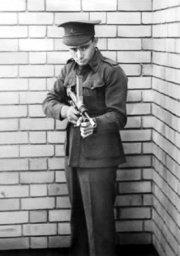Evelyn Owen
Evelyn Ernest Owen (15 May 1915 – 1 April 1949) was the Australian who developed the Owen Submachine Gun which was used in World War II, the Korean War and the Vietnam War.
Contents |
Early life
Evelyn Owen was born on 15 May 1915 in Wollongong, New South Wales. Despite the considerable efforts of his parents to steer him towards less dangerous pursuits, the young Owen was obsessed with guns; with making, modifying, and firing them. At the age of eight he began his experiments by building his own shotguns from which he would fire stones at rubbish heaps.
Over the years Owen pursued his hobby with great passion. He also pursued bomb making, once being wounded in the stomach by shrapnel from one of his explosives. On another occasion he shot himself in the stomach while trying out a new kind of bolt in an old rifle. He then turned his interest to sub-machine guns, making each of the prototypes himself, having learned metal and lathe work in the workshop of a family friend.
Invention of the Owen gun
The weapon that eventually bore his name, the Owen sub-machine gun, had its genesis in 1931, but he did not perfect it until 1938. Repeated testing proved that little could jam or interrupt the gun's rate of fire, making it superior to the Thompson gun. But the following year when he attempted to interest the military, Owen was rebuffed, being told that neither the Australian nor British armies had any need for such a weapon.
Owen enlisted in the AIF in May 1940. Just before embarking for the Middle East with his unit he managed to interest the manager of the Port Kembla plant of Lysaght's Newcastle Works, Vincent A. Wardell, in the gun. Wardell spoke to Sir Percy Spender, Minister for the Army, who had Owen transferred to the Central Inventions Board.
In June 1941 Owen was discharged from the AIF and began work at Lysaght who manufactured his gun. In September 1941 Owen's gun was ready for testing against similar weapons; the American Thompson, the British Sten and the German Bergmann. In the first test the Owen proved more accurate and able to group its shots better. Having then been variously immersed in water, mud and sand, the Owen proved itself almost impossible to jam while the other weapons faltered and eventually became unworkable. Those present at the test agreed that the Owen was the simplest, cheapest and toughest of sub-machine guns.
By late 1942 the Owen was being used in jungle fighting against the Japanese in New Guinea. More than 45,000 Owen guns were produced during the Second World War and they continued in use during the Korean War, the Malayan Emergency and in the early years of the Vietnam War.
Later life
Owen received £10,000 in royalties and from the sale of patent rights, and used the money to establish a sawmill near Wollongong, where he lived alone. A heavy drinker, Owen was admitted to Wollongong hospital where he died from a ruptured gastric ulcer on 1 April 1949 at the age of 33.
